
This is a partial list of weight training exercises organized by muscle groups.

This is a partial list of weight training exercises organized by muscle groups.
The human body can be broken down into different muscles and muscle groups, which can be worked and strengthened by exercise. This table shows major muscles and the exercises used to work and strengthen that muscle.
| Exercise | Calves | Quad- riceps | Ham- strings | Gluteus | Hips other | Lower back | Lats | Trapezius | Abdominals | Pectorals | Deltoids | Triceps | Biceps | Forearms |
|---|---|---|---|---|---|---|---|---|---|---|---|---|---|---|
| Squat | Some | Yes | Some | Yes | Yes | Some | Yes | |||||||
| Leg press | Some | Yes | Some | Yes | ||||||||||
| Lunge | Yes | Yes | Yes | Yes | ||||||||||
| Deadlift | Some | Yes | Yes | Yes | Yes | Yes | Some | Some | Some | |||||
| Leg extension | Yes | |||||||||||||
| Leg curl | Some | Yes | ||||||||||||
| Standing calf raise | Yes | |||||||||||||
| Seated calf raise | Yes | |||||||||||||
| Bench press | Yes | Some | Yes | |||||||||||
| Chest fly | Yes | Some | ||||||||||||
| Push-up | Yes | Some | Yes | |||||||||||
| Pull-down | Yes | Some | Some | |||||||||||
| Pull-up | Yes | Some | Some | Some | ||||||||||
| Bent-over row | Yes | Yes | Some | |||||||||||
| Upright row | Yes | Yes | Some | |||||||||||
| Shoulder press | Some | Yes | Yes | |||||||||||
| Lateral raise | Some | Yes | ||||||||||||
| Shoulder shrug | Yes | Some | ||||||||||||
| Pushdown | Yes | |||||||||||||
| Triceps extension | Yes | Some | ||||||||||||
| Biceps curl | Yes | Some | ||||||||||||
| Crunch | Yes | |||||||||||||
| Russian twist | Yes | |||||||||||||
| Leg raise | Yes | Some | ||||||||||||
| Back extension | Some | Yes | Yes | Yes | ||||||||||

The squat is performed by squatting down with a weight held across the upper back (below the neck) and standing up straight again. This is a compound exercise that also involves the glutes (buttocks) and, to a lesser extent, the hamstrings, calves, and the lower back. Lifting belts are sometimes used to help support the lower back. The freeweight squat is one of the three powerlifting competition exercises, along with the deadlift and the bench press. [2]
The leg press is performed while seated by pushing a weight away from the body with the feet. It is a compound exercise that also involves the glutes and, to a lesser extent, the hamstrings and the calves. Overloading the machine can result in serious injury if the sled moves uncontrollably towards the trainer. [3]
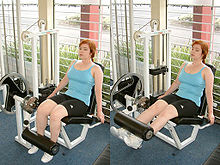
The leg extension is performed while seated by raising a weight out in front of the body with the feet. It is an isolation exercise for the quadriceps. Overtraining can cause patellar tendinitis. [4] The legs extension serves to also strengthen the muscles around the knees and is an exercise that is preferred by physical therapists. Needs citation
The wall sit, also known as a static squat, is performed by placing one's back against a wall with feet shoulder width apart, and lowering the hips until the knees and hips are both at right angles. The position is held as long as possible. The exercise is used to strengthen the quadriceps. Contrary to previous advice in this section, this exercise is NOT good for people with knee problems because the knees bear most of the load, especially when they are held at right angles (90 degrees).[ citation needed ]

The deadlift is performed by lifting a weight off of the floor until fully upright. This is a compound exercise that also involves the glutes, lower back, lats, trapezius (upper back), and, to a lesser extent, the quadriceps and the calves. Lifting belts are often used to help support the lower back. If performed with a barbell, it can be held with both hands facing backwards or with one hand facing backward and one facing forward. Both hands should not face forwards because this puts excess stress on the inner elbows.
The stiff-legged deadlift is a deadlift variation where little to no knee movement occurs, increasing hamstring, glute, and lower back activation. The bar starts on the floor and the individual sets up like a normal deadlift but the knees are at a 160° angle instead of 135° on the conventional deadlift.

The leg curl is performed while lying face down on a bench, by raising a weight with the feet towards the buttocks. This is an isolation exercise for the hamstrings. [5]
The snatch is one of the two current olympic weightlifting events (the other being the clean and jerk). The essence of the event is to lift a barbell from the platform to locked arms overhead in a smooth continuous movement. The barbell is pulled as high as the lifter can manage (typically to mid [ chest] height) (the pull) at which point the barbell is flipped overhead. With relatively light weights (as in the "power snatch") locking of the arms may not require rebending the knees. However, as performed in contests, the weight is always heavy enough to demand that the lifter receive the bar in a squatting position, while at the same time flipping the weight so it moves in an arc directly overhead to locked arms. When the lifter is secure in this position, he rises (overhead squat), completing the lift.
The Bulgarian Split Squat is a squat variation and is performed by resting the back foot on an elevated surface, such as a bench, with your other foot out in front of you on the floor. With a dumbbell in hand or body weight, you bend and lower your front leg until the dumbbell reaches the floor, and then using your front leg, push up into starting position. This exercise targets the hamstrings, glutes, and quadriceps, making it a great full-body movement. This movement also requires good balance and stability, so core strength is also an important aspect.

The standing calf raise is performed by plantarflexing the feet to lift the body. If a weight is used, then it rests upon the shoulders, or is held in the hand(s). This is an isolation exercise for the calves; it particularly emphasises the gastrocnemius muscle, and recruits the soleus muscle. [6]

The seated calf raise is performed by flexing the feet to lift a weight held on the knees. This is an isolation exercise for the calves, and particularly emphasises the soleus muscle. [7]


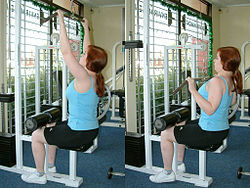


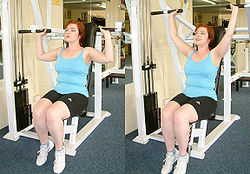

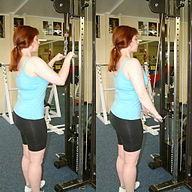


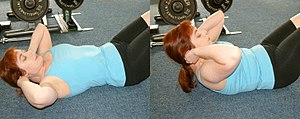


The back extension is performed while lying face down partway along a flat or angled bench, so that the hips are supported and the heels secured, by bending down at the waist and then straightening up again. This is a compound exercise that also involves the glutes.
The deadlift is a very effective compound exercise for strengthening the lower back, but also exercises many other major muscle groups, including quads, hamstrings and abdominals. It is a challenging exercise, as poor form or execution can cause serious injury. [8] A deadlift is performed by grasping a dead weight on the floor and, while keeping the back very straight, standing up by contracting the erector spinae (primary lower back muscle). When performed correctly, the role of the arms in the deadlift is only that of cables attaching the weight to the body; the musculature of the arms should not be used to lift the weight. There is no movement more basic to everyday life than picking a dead weight up off of the floor, and for this reason focusing on improving one's deadlift will help prevent back injuries.
Wrong technique and forward lean posture with a flexed spine can lead to discal injuries of the lower back. Correct technical performance with a slightly hollow or extended back and a hip hinge to keep the normal curvature of the spine is of utmost importance.
The good-morning is a weight training exercise in which a barbell, two dumbbells, or no weight at all is held on the shoulders, behind the head. The person bends forward and bows at the hips and recovers to upright. The good-morning is so called because the movement resembles bowing to greet someone. It involves the hamstrings but is primarily used to strengthen the lower back; the degree of knee bend used will change the focus – nearly straight-legged involving the hamstrings most.
Wrong technique and forward lean posture with a flexed spine can lead to discal injuries of the lower back. Correct technical performance with a slightly hollow or extended back to keep the normal curvature of the spine is of utmost importance.

Powerlifting is a strength sport that consists of three attempts at maximal weight on three lifts: squat, bench press, and deadlift. As in the sport of Olympic weightlifting, it involves the athlete attempting a maximal weight single-lift effort of a barbell loaded with weight plates. Powerlifting evolved from a sport known as "odd lifts", which followed the same three-attempt format but used a wider variety of events, akin to strongman competition. Eventually, odd lifts became standardized to the current three.

The clean and jerk is a composite of two weightlifting movements, most often performed with a barbell: the clean and the jerk. During the clean, the lifter moves the barbell from the floor to a racked position across the deltoids, without resting fully on the clavicles. During the jerk, the lifter raises the barbell to a stationary position above the head, finishing with straight arms and legs, and the feet in the same plane as the torso and barbell.

The bench press, or chest press, is a weight training exercise where a person presses a weight upwards while lying horizontally on a weight training bench. Although the bench press is a compound movement, the muscles primarily used are the pectoralis major, the anterior deltoids, and the triceps, among other stabilizing muscles. A barbell is generally used to hold the weight, but a pair of dumbbells can also be used.

A barbell is a piece of exercise equipment used in weight training, bodybuilding, weightlifting, powerlifting and strongman, consisting of a long bar, usually with weights attached at each end.
Bicep curls are a group of weight training exercises in which a person bends their arm towards their body at the elbow in order to make their biceps stronger.
Body for Life (BFL) is a 12-week nutrition and exercise program, and also an annual physique transformation competition. The program utilizes a low-fat high-protein diet. It was created by Bill Phillips, a former competitive bodybuilder and previous owner of EAS, a manufacturer of nutritional supplements. It has been popularized by a bestselling book of the same name.

A squat is a strength exercise in which the trainee lowers their hips from a standing position and then stands back up. During the descent, the hip and knee joints flex while the ankle joint dorsiflexes; conversely the hip and knee joints extend and the ankle joint plantarflexes when standing up. Squats also help the hip muscles.

The deadlift is a weight training exercise in which a loaded barbell or bar is lifted off the ground to the level of the hips, torso perpendicular to the floor, before being placed back on the ground. It is one of the three powerlifting exercises, along with the squat and bench press, as well as a frequent lift in strongman.

The lying triceps extension, also known as skull crusher and French extension or French press, is a strength exercise used in many different forms of strength training. It is one of the most stimulating exercises to the entire triceps muscle group in the upper arm, and works the triceps from the elbow all the way to the latissimus dorsi. Due to its full use of the triceps muscle group, the lying triceps extensions are used by many as part of their training regimen.

In weight training, a kettlebell is a cast-iron or cast-steel ball with a handle attached to the top. It is used to perform many types of exercises, including ballistic exercises that combine cardiovascular, strength and flexibility training. Kettlebells are the primary equipment used in the weight-lifting sport of kettlebell lifting.
The good-morning is a weight training exercise. It is known as a good morning because of the movement in the erector spinae which resembles the bow that traditionally begins a schoolday in some East-Asian countries. The erector spinae muscles of the lower back work isometrically to keep the spine in an extended position while the hamstrings and gluteus maximus work isotonically to perform hip extension. Other muscles are involved in stabilizing weight on the back and maintaining balance.
A bent-over row is a weight training exercise that targets a variety of back muscles. Which ones are targeted varies on form. The bent over row is often used for both bodybuilding and powerlifting.

Vincent Anselmo Gironda was an American professional bodybuilder, personal trainer, author, co-founder of the supplement company NSP Nutrition, and owner of the celebrity-frequented Vince's Gym. His nickname was the "Iron Guru".

The pull-down exercise is a strength training exercise designed to develop the latissimus dorsi muscle. It performs the functions of downward rotation and depression of the scapulae combined with adduction and extension of the shoulder joint.

The following outline is provided as an overview of and topical guide to exercise:
The upright row is a weight training exercise performed by holding a weight with an overhand grip and lifting it straight up to the collarbone. This is a compound exercise that involves the trapezius, the deltoids and the biceps. The narrower the grip the more the trapezius muscles are exercised, as opposed to the deltoids.

A fly or flye is a strength training exercise in which the hand and arm move through an arc while the elbow is kept at a constant angle. Flies are used to work the muscles of the upper body. Because these exercises use the arms as levers at their longest possible length, the amount of weight that can be moved is significantly less than equivalent press exercises for the same muscles . Due to this leverage, fly exercises of all types have a large potential to damage the shoulder joint and its associated ligaments and the tendons of the muscles connecting to it. They should be done with caution and their effects first tested while using very light weights; which are gradually incremented after more strength is gained.

A dip is an upper-body strength exercise. Close grip dips primarily train the triceps, with major synergists being the anterior deltoid, the pectoralis muscles, and the rhomboid muscles of the back. Wide shoulder width dips place additional emphasis on the pectoral muscles, similar in respect to the way a wide grip bench press would focus more on the pectorals and less on the triceps.
The rear delt raise, also known as the rear deltoid raise, or rear shoulder raise is an exercise in weight training. This exercise is an isolation exercise that heavily works the posterior deltoid muscle. The movement is primarily limited to the two shoulder joints: the glenohumeral joint and the scapulothoracic joint. Scapular movement will also cause movement in the sternoclavicular joint and acromioclavicular joint. If the elbow bends during the extension exercises, it gravitates into a rowing motion.
Split weight training is a type of exercise workout routine. It is a workout regimen where different muscle groups are targeted on separate days, rather than exercising the entire body in a single session. This type of training allows for focused work on each muscle group while providing appropriate recovery time between training on the same muscle. This type of training is mostly used by bodybuilders and fitness trainers, while professional lifters typically avoid this approach.